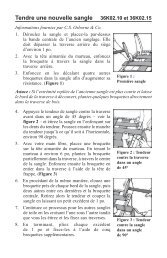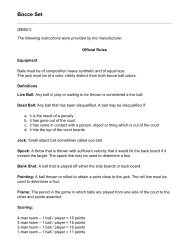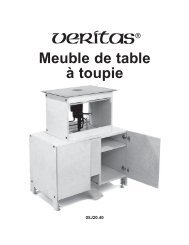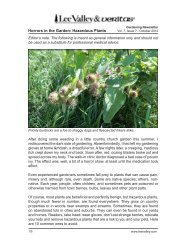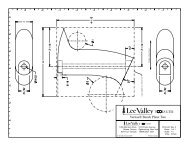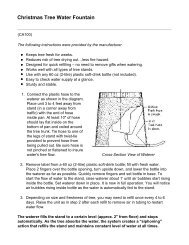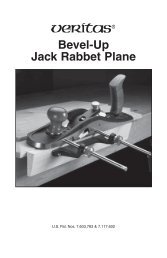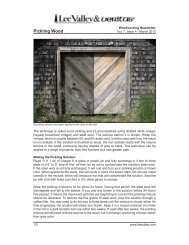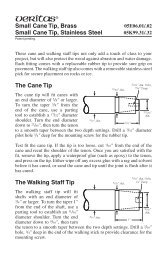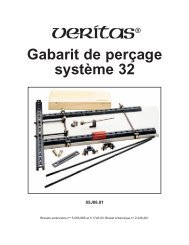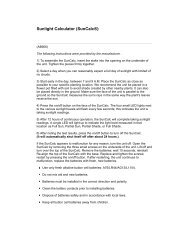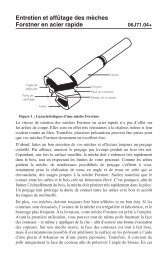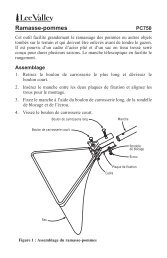Orange Shellac - Lee Valley Tools
Orange Shellac - Lee Valley Tools
Orange Shellac - Lee Valley Tools
You also want an ePaper? Increase the reach of your titles
YUMPU automatically turns print PDFs into web optimized ePapers that Google loves.
<strong>Orange</strong> <strong>Shellac</strong> 56Z40.01 & .02<br />
Note: This is a natural product; the fl akes can vary considerably in color.<br />
However, when mixed into a liquid, the resulting shellac will be within an<br />
acceptable range of orange.<br />
General Dissolving Information<br />
<strong>Shellac</strong> is an excellent finish, but a user requires experience in order to<br />
employ it to its full potential. The consistency of shellac is determined<br />
by "cut". A 3 lb cut would be 3 lb (1.36kg) of shellac flakes per U.S.<br />
gallon (3.8 litres) of alcohol solvent. If you have never worked with shellac<br />
before, it is recommended that you start with a light consistency, preferably<br />
about a 1 lb cut. This is approximately a 1:8 ratio of shellac to alcohol.<br />
Therefore, 1 oz (28g) of shellac would be dissolved in 8 fl oz (236ml) of<br />
denatured alcohol. Heavier cuts can be used, but it is best to apply many<br />
thin coats rather than a few heavy ones. The heavier the cut, the quicker<br />
the shellac dries. A thinner cut will give an inexperienced user more time<br />
to spread the shellac before it becomes tacky.<br />
After the shellac is fully dissolved, it should be strained through fine-mesh<br />
cheesecloth before use to remove any impurities. <strong>Shellac</strong> is made from the<br />
secretions of the lac insect and a few bits of insect carcass are often left in<br />
the shellac flakes.<br />
Application<br />
Before shellac in the liquid state is used, it should be shaken or stirred<br />
thoroughly and allowed to stand for a few hours. <strong>Shellac</strong> should be applied<br />
in long strokes with the grain. A good-quality brush with a chisel tip<br />
should be used. Its bristles should be dipped about 3 /4 of the way into<br />
the shellac and gently cleared of excess shellac against the rim of the<br />
container. (Metal cans should not be used; the shellac will react with the<br />
metal, which will darken the shellac.) This gives a reasonably full brush for<br />
full strokes without incorporating any air in the shellac. <strong>Shellac</strong> should be<br />
sanded between coats and each coat should be allowed to dry thoroughly.<br />
If the shellac is dry, sanding will produce a fine powder on the surface.<br />
If the shellac is not dry, it will be somewhat tacky to sand and the paper<br />
will clog. After sanding, the piece should be wiped thoroughly with a tack<br />
cloth and recoated. Depending upon temperature and humidity conditions,<br />
you should allow between two and four hours for each coat to dry. Some<br />
craftsmen prefer to do their finish sanding of the raw wood after first giving<br />
it a coat of shellac, since this stiffens the wood fibers and allows any rough<br />
portions to be fully sanded off.
After the desired number of coats have been applied, the finish can be<br />
rubbed with 0000 steel wool or FFF pumice with paraffin oil. Rubbing<br />
should always be done with the grain. If it is desired, a coat of paste wax<br />
can be applied 24 hours after the final rubbing and the surface buffed to<br />
a finish.<br />
Safety and Storage Precautions<br />
Keep out of reach of children. Wear a dust mask when sanding between<br />
coats. Store in a cool, dry place.<br />
647<br />
© <strong>Lee</strong> <strong>Valley</strong> <strong>Tools</strong> Ltd. 2009<br />
www.leevalley.com<br />
1090 Morrison Drive 814 Proctor Avenue<br />
Ottawa, Ontario Ogdensburg, New York<br />
K2H 1C2 Canada 13669-2205 USA<br />
1-800-267-8761 1-800-267-8735<br />
customerservice@leevalley.com<br />
INS-062 Rev. C<br />
Printed in Canada.



